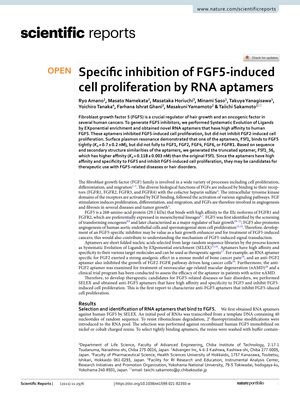TLDR RNA aptamers can specifically block FGF5-related cell growth, potentially treating related diseases or hair disorders.
Researchers developed RNA aptamers that specifically inhibited FGF5-induced cell proliferation without affecting FGF2-induced proliferation. One aptamer, F5f1, showed high affinity to FGF5 (Kd = 0.7 ± 0.2 nM) and not to other FGFs or FGFR1. A truncated version, F5f1_56, exhibited even higher affinity (Kd = 0.118 ± 0.003 nM). These aptamers could potentially be used therapeutically for FGF5-related diseases or hair disorders due to their high specificity and inhibitory effects on FGF5.
 103 citations
,
June 2018 in “International Journal of Molecular Sciences”
103 citations
,
June 2018 in “International Journal of Molecular Sciences” FGF signaling is a promising target for developing treatments for wounds, metabolic diseases, and cancer.
136 citations
,
July 2014 in “Proceedings of the National Academy of Sciences of the United States of America” FGF5 gene mutations cause unusually long eyelashes by affecting hair growth regulation.
April 2025 in “Materials Today Bio” A new treatment using gold nanoclusters can safely reduce unwanted hair growth.
 61 citations
,
September 2010 in “Genomics”
61 citations
,
September 2010 in “Genomics” The study found that immune responses disrupt hair growth cycles, causing hair loss in alopecia areata.
 11 citations
,
October 2021 in “Frontiers in Cell and Developmental Biology”
11 citations
,
October 2021 in “Frontiers in Cell and Developmental Biology” Non-coding RNAs are important for hair growth and could lead to new hair loss treatments, but more research is needed.
 27 citations
,
February 2017 in “Clinical, Cosmetic and Investigational Dermatology”
27 citations
,
February 2017 in “Clinical, Cosmetic and Investigational Dermatology” New compounds were found to help increase hair growth and decrease hair loss.
 23 citations
,
May 2020 in “Cell Death and Disease”
23 citations
,
May 2020 in “Cell Death and Disease” Blocking the FGF5 gene in sheep leads to more fine wool and active hair follicles due to changes in certain cell signaling pathways.





